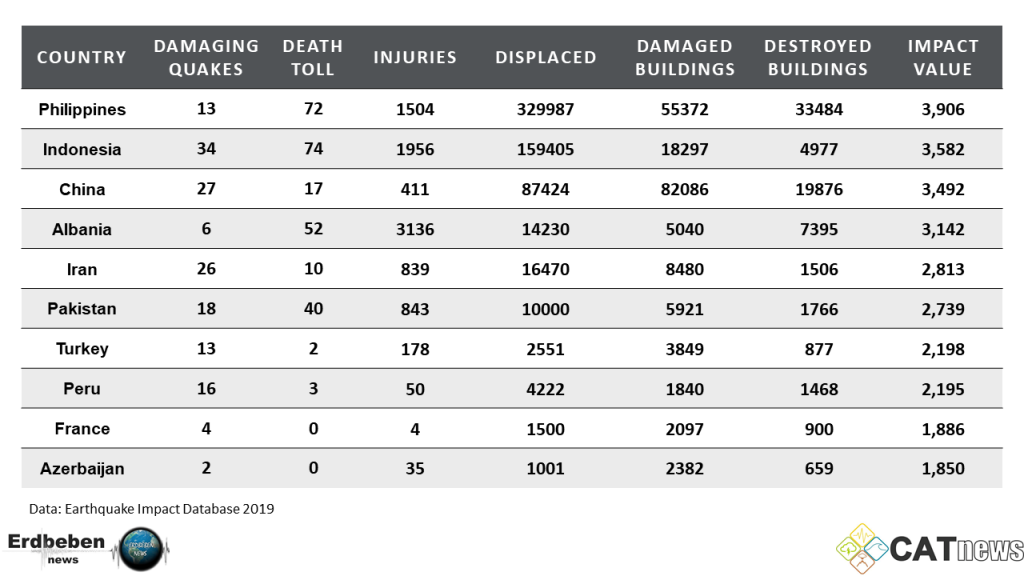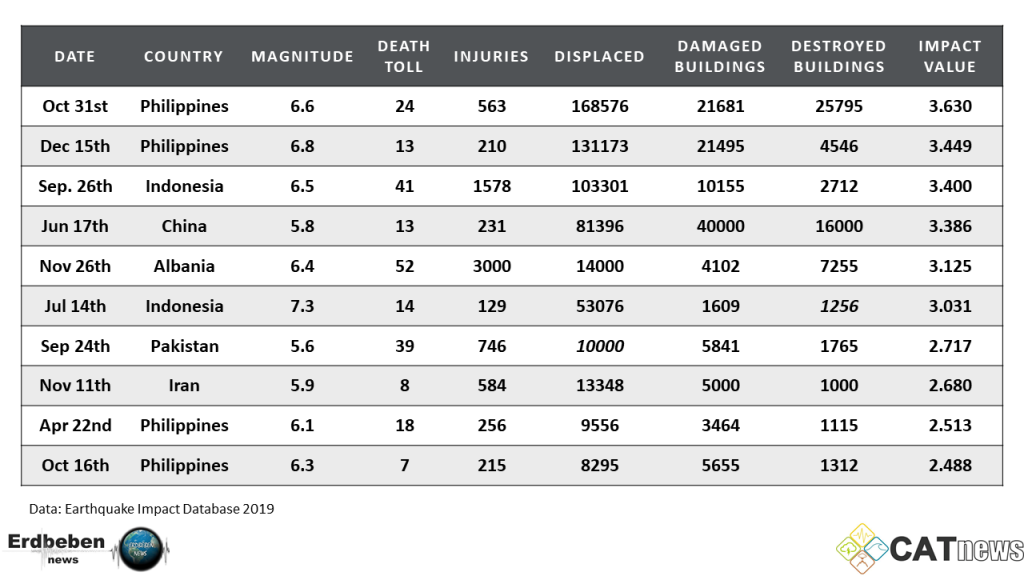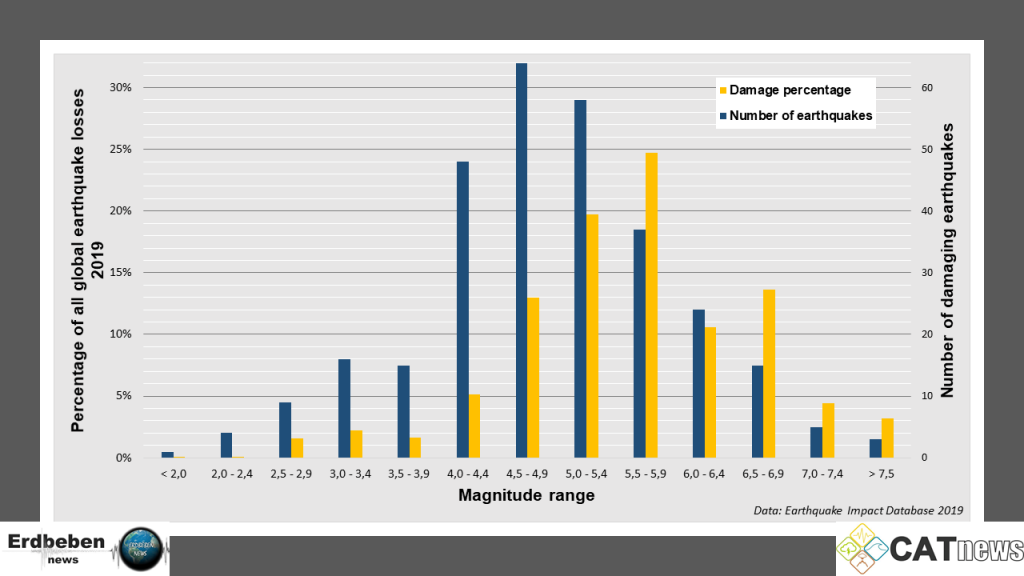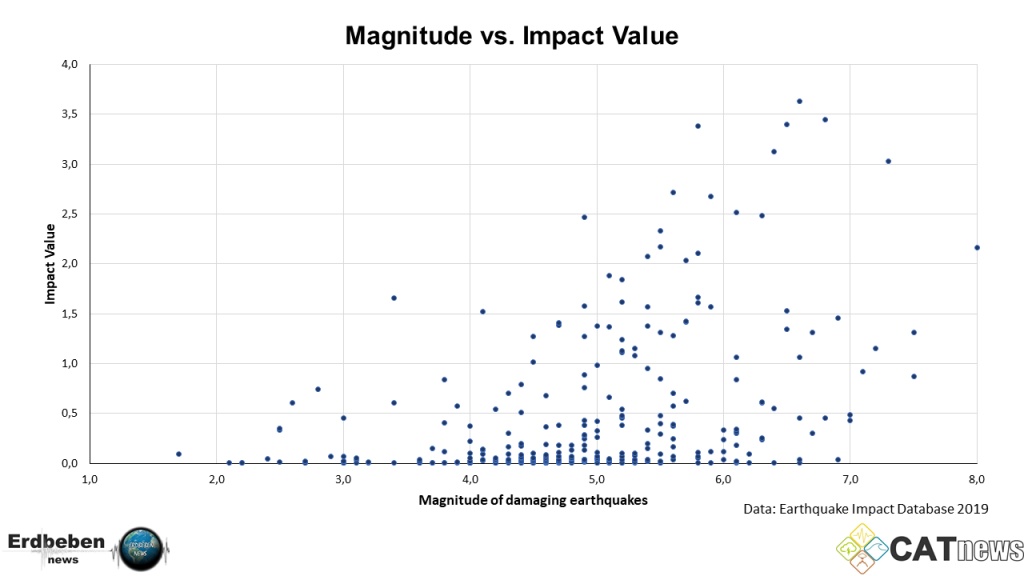The 2010s will be associated with several terrible earthquake catastrophes. In 2010 a magnitude 7 quake devastated large parts of Haiti, killing over 100,000 people and leaving deep socioeconomic scars. A year later, the well-known tsunami disaster in Japan with around 20,000 victims followed 9.1 magnitude quake, which led to a meltdown at the Fukushima nuclear power plant. In 2015 it was Nepal where almost 10,000 people died after a magnitude 7.8 quake – the strongest in the Himalaya region in 65 years.
A seismically active phase stretched from the beginning of the 21st century to the mid-2010s, which – thanks to the still young Internet – quickly had the potential to spread rumors and conspiracy theories about a cataclystic increase in activity.
But during the latter half of the decade global seismicity waned: since 2017, record minimums have followed record minimums. The lowest number of strong earthquakes, the longest period without a strong earthquake, earthquake droughts (e.g. California) and, as in 2019, the lowest number of victims in decades. A look back on the quiet end of two decades full of catastrophes.
The latest casualty figures and statistics on earthquake damage are created with Earthquake Impact Database, established in 2013, the world’s most comprehensive compilation of earthquake damage and losses. All earthquakes that have caused damage to buildings of any kind or injuries to people are listed there. Around 2000 earthquakes were recorded in the database in the seven years.

First, a few statistics: The total number of earthquakes in 2019 was slightly below the long-term average. The United States Geological Survey (USGS) detected 1,500 earthquakes of magnitude 5 or higher around the world during the year. These tremors reached magnitude 6 133 times, only nine times (the second lowest value of the 21st century) magnitude 7 and once magnitude 8.
These are average to below average numbers, which is mainly due to the lack of large earthquakes with active aftershock sequences. The total number of damaging earthquakes is therefore significantly lower than in the years 2013 to 2016: A total of 299 damaging earthquakes have been detected so far, which is a slight increase compared to the previous years 2017 and 2018. These 299 earthquakes resulted in a total of 289 fatalities (43 fatal earthquakes), 9,199 injuries and around 274,000 damaged buildings. 630,000 people had to be evacuated or relocated due to earthquake damage.
The two hardest hit countries in 2019 were the Philippines and Indonesia.
The Philippines have experienced a high number of more or less catastrophic earthquakes during the year. Starting with a strong earthquake in April on the northern island of Luzon, which claimed 18 victims. There were a total of 13 damaging quakes, of which seven quakes resulted in a total of 72 deaths. Nine people died in July after a small series of earthquakes in the far north of the archipelago. A strong earthquake series that lasted for several weeks was much more devastating, affecting large parts of the southern island of Mindanao.

This earthquake sequence was one of the worst and at the same time (from a scientific point of view) fascinating highlights of the year. Along a fault zone that crosses Mindanao from northwest to the southeast, a chain reaction took place since October, in which one strong earthquake triggered another a few kilometers away. Four of these quakes were stronger than magnitude 6, most recently in mid-December. As a large area was affected by the shifting epicentres, the damage was immense: more than 80,000 buildings were damaged or destroyed, 45 people killed and around 1,000 were injured due to these shocks.
It is uncertain whether the chain reaction came to an end with the last quake in December. The reconstruction and relief work for 100,000 affected people will definitely continue for some time.
Indonesia was spared strong catastrophes this year, unlike those which struck in the second half of 2018 in Lombok, Sulawesi and Sumatra-Java (the Krakatau tsunami). However, with a total of 34 damaging earthquakes, Indonesia is the country with the highest number of damaging quakes in 2019. 74 people died as a result of these quakes, although „only“ (compared to the Philippines) 23,000 buildings were damaged Thus the ratio of human victims to property damage is three times higher in Indonesia than the global average. Only Guatemala and Algeria (with only two or one damaging quakes) have a higher ratio.
The city of Ambon was affected by the deadliest quake of the year in Indonesia. The magnitude 6.5 quake on September 26 destroyed and damaged a total of 12,000 buildings in Ambon and the surrounding area. Due to the high population density in the region, the quake led to a relatively high number of casualties. Over 1,500 people were injured by falling debris and panic, 41 of whom did not survive the earthquake. Large aftershocks, some of them occurring weeks later, also killed three people who were in buildings that were already damaged.

Relief work was problematic in the second major earthquake of the year in Indonesia. There, however, it was not the high, but the low population density that was fatal. The 7.3 magnitude quake on July 14 hit the very remote south of the island of Halmahera. There is little infrastructure in this rainforest region. The few villages are mostly traditional and poorly protected against earthquake damage. Around 2,800 of the buildings there were damaged or destroyed by the earthquake. 14 people died, eight of them in the aftermath days after the quake because medical help was not available.
Psychological effects caused by the catastrophes in Lombok, Sulawesi and Anak Krakatau are still having a negative influence in Indonesia. People quickly panic in case of an earthquake, they are susceptible to misinformation, they distrust the authorities, and sometimes contribute to dangerous situations by their own behavior. The events in 2019 showed that it is not always just the natural event that is the cause of a disaster. Human behavior, both by those affected and by those providing assistance, can significantly influence its extent.
A similar situation occurred in Albania during the deadliest earthquake of the year. 52 people died when a 6.4 magnitude quake struck the densely populated Durres region west of the capital Tirana on November 26. Although the earthquake did not come as a complete surprise – a strong sequence of earthquakes had shaken the region for months, even in the hours before the catastrophe there were foreshocks, which might have been a life-saving alarm signal for some people – it was the worst earthquake disaster for the country in decades. Around 11,000 buildings were damaged and around 4,000 people injured. Allegations to the authorities have been made, criticizing that earthquake-proof construction has been neglected in recent decades. A political aftershock sequence is therefore imminent.

China is traditionally one of the countries with the most earthquake damage and highest number of damaging earthquakes. High earthquake activity, high population density, less earthquake-resistant buildings – a combination that regularly brings China to the top of the list of the most affected countries. In this year, which is rather earthquake-free by Chinese standards, China ended with the third highest damage coefficient.
27 damaging quakes with a total of 17 fatalities and 100,000 damaged buildings are recorded. Unlike in previous years, Sichuan province became the place where most of the damaging quakes (9) occurred. This time, humans could also have a significant on this. Seven of the nine damaging quakes in Sichuan are at least suspected to be induced by human activities, more precisely by hydraulic fracturing or the injection of wastewater into the rock as a result of natural gas production. So far there is no confirmation or proof for this theory, but the spatial and temporal correlation are strong indicators. The most devastating earthquake of the year in China on June 17 (magnitude 5.8), in which 13 people were killed, could have been the most serious and strongest earthquake ever caused by natural gas production. Two further fatal earthquakes on September 7 (M5.4, 1 victim) and on February 25 (M4.9, 2 victims) are also suspected to have been induced. At least in the second case, the suspicion is supported by the shallow hypocenter and previous quakes in the immediate vicinity, which have been confirmed to be induced by fracking. Due to the political situation in China, however, no political consequences are to be expected here, unlike in England, the Netherlands, France and Germany, where induced earthquakes led to a shut down of fracking, natural gas production and geothermal projects this year.
After a few very active, sometimes catastrophic years, 2019 was comparatively harmless for Iran. In total (for Iranian conditions) „only“ 26 damaging quakes occurred. A total of 10 people died nationwide and around 10,000 buildings were damaged. The most serious consequences followed the quake in East Azerbaijan (M5.9) on November 7th, which claimed a total of eight lives and damaged or destroyed around 6,000 buildings.
The neighboring country of Azerbaijan was not spared by earthquakes either. The February 8 earthquake (M5.2) in Shamakhi province did not result in fatalities, but left 30 people injured, around 1,000 people homeless and 3,000 buildings damaged – the most devastating earthquake in the Caucasus Republic in decades.
The situation was much worse in the densely populated north of Pakistan, where at the end of September a 5.6 magnitude earthquake damaged or destroyed more than 7,000 buildings, roads and bridges, killing 39 people and leaving around 10,000 residents homeless. In total, Pakistan had eight confirmed damaging quakes in 2019, but the sometimes difficult information situation suggests a certain number of unreported cases.

If you have a look at the biggest earthquakes of the year, you will notice that many of them have done relatively little, sometimes no damage at all. Only the previously mentioned quake on Halmahera, as well as the strongest earthquake of the year, a magnitude 8 earthquake in Peru, had a major impact. In Peru and parts of Ecuador and Colombia, the quake damaged over 2,000 buildings. Two people were killed and 25 others injured. The state of emergency declared by the authorities after the earthquake was maintained until the end of the year to support the relief work there. Overall, however, the damage is relatively small for an earthquake of this size, which is mainly due to the large depth of the quake.
The earthquake with probably the greatest economic losses occurred in the US state of California and ended the decade-long period there without a major earthquake, called earthquake drought by some scientists. The small town of Ridgecrest in the Mojave Desert was hit by a magnitude 7.1 quake (as well as strong foreshocks and aftershocks). A low population density and typical Californian earthquake-proof buildings have prevented worse things here. There were only a few injuries and buildings destroyed. However, a large military facility was affected by the quake. The damage there alone amounted to several billion US dollars. In the economically independent statistics of the Earthquake Impact Database, however, the Ridgecrest earthquake is only ranked as the 55th most destructive quake.
Two other major earthquakes (magnitude 7.5 and 7.2) hit two different regions of Papua New Guinea only a few days apart in May, causing damage to several hundred buildings. There was an injured man and a small tsunami in one of these quakes. The larger one hit the island of Latangai and was of particular scientific interest because it occurred in a large fault zone (Weitin fault), where the last major earthquake (magnitude 8) occurred only 19 years earlier. Although the Weitin fault is considered to be one of the faults with the highest slip rate, it is unusual for two earthquakes of this size to occur in such a short space of time.
The origin of a strong earthquake (M5.1) in southern France on November 11 is also unusual, not just because it was one of the country’s strongest earthquakes in decades. Not only due to an unusually shallow depth (which resulted in high intensity with corresponding damage in the immediate vicinity of the epicenter) but also due to a focal mechanism which indicates reactivated faulting in the opposite direction of the original faulting style. As a possible trigger for this quake, which damaged or destroyed 3,000 buildings and injured four people, a large quarry is suspected, which is located directly above the fault trace. Such a reactivation could be explained by the removed rocks. However, the authorities largely excluded this option in a preliminary report. Questions remain open, the research for answers will continue.
Many countries that are often affected by quakes were mostly spared this year, including Japan, Chile (despite four fatalities) and Mexico. In general, North and Central America were largely lucky this year. After Africa, it is the continent with the second least earthquake damage. Asia accounts for 90% of all earthquake damage in the year, Europe for 8,6%.

All earthquakes and all international and intercontinental statistics can be viewed in the Earthquake Impact Database. There, a value („Impact Value“) is calculated for each quake based on the respective losses, which allows an economically independent comparison of different events. Two of the Mindanao earthquakes are at the top of this damage ranking with impact values of 3.63 and 3.45, followed by the Ambon earthquake (3.40) and the major Sichuan earthquake (3.39). The world’s deadliest earthquake of the year in Albania reached an impact value of 3.12. 13 other quakes are classified with a value of 2 or higher, which corresponds to serious or catastrophic damage. These quakes had magnitudes between 4.9 and 8.0. The weakest event in the Impact Database this year was a magnitude 1.7 quake. It was part of a (very likely induced) earthquake sequence in the Indian state of Madhya Pradesh that damaged dozens of buildings. A total of 40 damaging earthquakes under magnitude 4 were registered, including a mining-induced rockburst in Poland, induced earthquakes in England, the Netherlands and other regions of India, but also tectonic earthquakes, e.g. in El Salvador, Tunisia and Brazil. However, there is still a large data gap, especially in the area of small to moderate damaging earthquakes, since only a few cases of minor damage reach the public via media or authority reports.
The catalog of major damaging quakes can be assumed to be (almost) complete, which makes the Impact Database currently the best damage statistics for earthquakes in the world.
The year 2019 is over. The earthquakes will continue. We will see whether the trend of the past few years will continue, bringing a more inactive time or whether we will experience a major catastrophe again, as seen multiple times in the beginning of the 21st century. In years with catastrophic earthquakes, these individual events are usually the ones that contribute the most to total global losses. The absence of major disasters in 2019 allowed a clear view on something that is otherwise hidden in the shadows of the biggest events. A clear view on background activity of a dynamic planet.